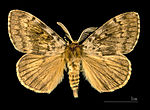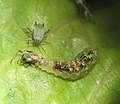Lymantria dispar, also known as the gypsy moth or the spongy moth, is a species of moth in the family Erebidae native to Europe and Asia. Lymantria dispar...
14 KB (1,290 words) - 01:48, 3 October 2024
Lymantria dispar dispar, commonly known as the gypsy moth, European gypsy moth, LDD moth, or (in North America) North American gypsy moth or spongy moth...
39 KB (4,610 words) - 20:44, 10 November 2024
Lymantria dispar asiatica, the LDA moth or Asian spongy moth, also known as the Asian gypsy moth, is a moth in the family Erebidae of Eurasian origin....
10 KB (1,050 words) - 05:36, 3 September 2024
Lymantria dispar japonica, also known as the Japanese gypsy moth, is a moth in the family Erebidae of Eurasian origin.: 5 Lymantria dispar japonica was...
3 KB (356 words) - 05:21, 29 July 2023
Lymantria dispar multicapsid nuclear polyhedrosis virus or LdMNPV is a viral infection in spongy moths (Lymantria dispar) that causes infected larvae to...
21 KB (2,420 words) - 07:24, 15 August 2024
The spongy moth (Lymantria dispar), formerly known as the gypsy moth, was introduced in 1868 into the United States by Étienne Léopold Trouvelot, a French...
27 KB (3,156 words) - 07:10, 30 July 2024
Walker, 1865 Lymantria dictyodigma Collenette, 1930 Lymantria didymata Kenrick, 1914 Lymantria diehli Schintlmeister, 198? Lymantria dispar Linnaeus, 1758...
17 KB (1,257 words) - 03:37, 25 October 2024
include corn borers and bollworms. The caterpillar of the spongy moth (Lymantria dispar) causes severe damage to forests in the northeastern United States...
31 KB (3,115 words) - 13:15, 4 September 2024
ground beetle is a voracious consumer of caterpillars (especially Lymantria dispar, Thaumetopoea processionea, Thaumetopoea pityocampa and Euproctis chrysorrhoea)...
5 KB (414 words) - 17:31, 1 October 2024
moths. Lymantria means "destroyer", and several species are important defoliators of forest trees, including the spongy moth Lymantria dispar, the Douglas-fir...
12 KB (1,446 words) - 04:26, 27 September 2024
instance, the common Pimpla rufipes parasitizes Pieris brassicae and Lymantria dispar. They are generally sturdy black wasps with orange markings. The first...
4 KB (243 words) - 12:13, 15 March 2024
Europe and Japan to look for natural enemies of the spongy moth, Lymantria dispar dispar, and the brown-tail moth, Euproctis chrysorrhoea, invasive pests...
91 KB (9,475 words) - 22:10, 5 October 2024
disperse through ballooning, covering greater distances compared to the Lymantria dispar and exhibiting high rates of settling. Larvae have also been recorded...
4 KB (335 words) - 17:58, 14 March 2024
Gypsy moth in New Zealand (category Lymantria dispar)
species in New Zealand Gypsy moths in the United States "Eradicated - Lymantria dispar". Biosecurity New Zealand. 22 October 2008. Retrieved 29 June 2010...
3 KB (344 words) - 10:51, 24 April 2023
Among the most conspicuous is that of the introduced spongy moth (Lymantria dispar), which infests primarily oaks, causing severe defoliation and tree...
86 KB (9,194 words) - 09:33, 12 November 2024
during the day and only feed at night. Others, such as spongy moth (Lymantria dispar) larvae, change their activity patterns depending on density and larval...
41 KB (4,307 words) - 11:18, 5 September 2024
C19H38O. It is a sex pheromone found in moths, such as the spongy moth (Lymantria dispar), and is used to attract a mate. Disparlure is produced by female moths...
8 KB (811 words) - 02:58, 17 September 2024
such as anti-BCJ and anti-BLD separated from Charybdis japonica and Lymantria dispar, respectively, are of value both in routine blood grouping and research...
30 KB (3,038 words) - 13:30, 24 October 2024
beetles, aphids, lace bugs and various species of moths, such as Lymantria dispar dispar (Gypsy moth). This moth is one of the top 100 invasive species...
20 KB (2,122 words) - 16:09, 7 November 2024
Cherax destructor Vairimorpha disparis - a parasite of the moth, Lymantria dispar Vairimorpha ephestiae - a parasite of the wax moth, Galleria mellonella...
1 KB (98 words) - 11:07, 18 January 2023
body to pupate. Some species parasitized by Glyptapanteles include Lymantria dispar, Chrysodeixis chalcites, Thyrinteina leucocerae (both pictured), and...
10 KB (900 words) - 22:17, 8 June 2024
niger) 60 154 Bengal fox (Vulpes bengalensis) 60 155 Gypsy moth (Lymantria dispar dispar) 62 156 Donkey (Equus asinus) 62 157 Scarlet macaw (Ara macao)...
103 KB (5,184 words) - 04:33, 19 October 2024
undergone changes. Ld130, also known as baculovirus F-protein from Lymantria dispar (LdMNPV) is suggested to be an ancestral envelope fusion protein which...
23 KB (2,629 words) - 23:18, 16 August 2024
defoliating insects that attack chinquapin oak are the gypsy moth (Lymantria dispar), the orangestriped oakworm (Anisota senatoria), and the variable oakleaf...
15 KB (1,669 words) - 09:24, 17 September 2024
"Effect of the cardenolide digitoxin on performance of gypsy moth (Lymantria dispar) (Lepidoptera: Lymantriidae) caterpillars". The Great Lakes Entomologist...
27 KB (2,808 words) - 04:12, 30 July 2024
the population of an exotic forest, univoltine, spongy moth named Lymantria dispar. It is an endoparasitoid of larvae and lives with its host for most...
14 KB (1,174 words) - 14:16, 28 October 2024
butterflies damage the cork oak, the most important being the spongy moth (Lymantria dispar). The species lays its eggs in the bark of the branches and trunks...
32 KB (3,831 words) - 12:30, 23 September 2024
the Columbian timber beetle (Corthylus columbianus). The gypsy moth (Lymantria dispar) feeds on foliage and is potentially the most destructive insect. Although...
16 KB (2,037 words) - 11:02, 29 August 2024
(Unix), a utility to List Dynamic Dependencies Living Dead Dolls Lymantria dispar dispar, a species of moth (gypsy moth) This disambiguation page lists...
1 KB (164 words) - 04:41, 26 July 2024
Caribbean, Western Europe, and East Asia. Native to eastern North America. Lymantria dispar Insect Asian gypsy moth, Asian spongy moth, spongy moth Invasive worldwide...
27 KB (616 words) - 04:05, 20 October 2024
























